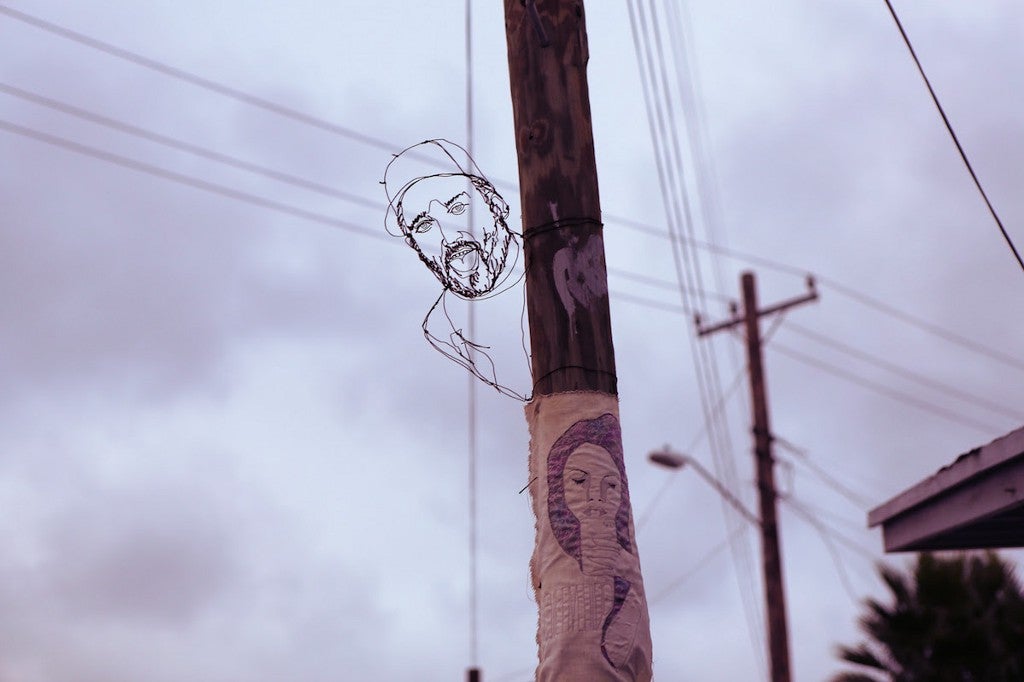No destination better symbolizes the recent cultural renaissance in Tijuana — the Mexican border-city, which until 2008, was synonymous with the country’s narco violence — than La Casa del Túnel: Art Center, an unassuming triangle-shaped building only a few hundred yards from the busiest border crossing in the world. Just a dozen years ago, it housed the entrance to an underground drug-running tunnel, where smugglers used pulleys to cart product under the border into California. (In 2004, the U.S. government found roughly 60 tunnels of this nature after post-9/11 raids cracked down on such leaky faucets.) Today, this former node in the drug trade exhibits art, promotes sustainability and hosts workshops and events for people of all ages. More importantly, the center anchors a larger arts community that people are crossing the border the other way, into Mexico, to join.
“Here, you can do a lot and still have an impact on the local scene. That feels rewarding.” says David Peña, an American illustrator who, along with his photographer-videographer brother Daniel, moved to Tijuana from Chula Vista (10 miles north in California) in 2014 and opened the gallery Out Here in 2015, across the street from the Túnel and below their living space. Like others in Tijuana’s art scene, the art they make or show deals with questions of hybrid-identity that preoccupy citizens of any border town; and they’ve done things in a completely DIY manner, with little institutional support. Together, however, they’ve provoked a cultural revolution in Tijuana that’s helped revitalize the city in the wake of one its darker moments: the drug war of the mid-aughts, which hit Tijuana especially hard, before peaking in 2008 and making way for a cultural renaissance, not only in the arts, but in music and food as well.
Groups like Maria y Jose, Los Macuanos and Santos have brought outside attention to the music scene’s homegrown genre ruidosón, a fusion of traditional sounds like cumbia or banda with acid techno and noise. That music has packed locals into warehouses and clubs on Calle Sexta, the offbeat alternative to the main party drag Avenida Revolución — TJ’s answer to Bourbon Street. Meanwhile, farm-to-table restaurants in the Valle de Guadalupe — the Napa of Baja, just an hour’s drive away — and a craft beer scene vibrant enough to support its own Oktoberfest, has given more tourists a reason to cross the border. But it’s the cheap cost of living (especially when compared to Los Angeles and San Francisco) that has given artists a reason to stay.
“Someone told me recently about a studio space they found in San Diego near the beach that was $1,600 a month,” says Rebecca Goldschmidt, an American photographer from Chicago who arrived in Tijuana last year. “That was supposed to be super cheap. But that’s like three months of living down here.” Goldschmidt can work a few days a week in San Diego and earn enough money to survive in Tijuana while planning an ambitious-but-underfunded cultural event: FiFT, the first ever full-blown photography festival in Tijuana. “There was no grant,” she explains. “This is all super DIY. It’s just how it is. There’s literally zero dollars.”
Things weren’t always so extreme, according to Angelica Escoto, a Mexican photographer who arrived in Tijuana in 1991, when the city was in the midst of a small cultural boom. “A couple of artists broke out and got a bunch of attention,” Escoto says, remembering the work of Julio Orozco and Tania Candiani, who showed internationally. “They went to Russia and Italy [and came back with this exciting knowledge] and produced a lot.” The soundtrack to their work was provided by Nortec Collective’s brand of electronica in the 1990s and indie rock in the early 2000s, led by promoters who would rent out abandoned movie theaters and other derelict venues to throw shows.

But everything stopped in 2006 with the onset of la guerra sucia. As the local TJ cartel battled the Sinaloa cartel for control of the world’s most valuable passage for drug trafficking (i.e., the California-Mexico border), the body count rose, and the streets filled with soldiers. “Everyone was afraid that if you walked down the street, you’d get shot from random gunfire,” Escoto says. “You’d wake up and watch the news and see all these bodies hanging from bridges. People with their head cut off with a little note attached.” One notorious henchman earned the nickname El Pozolero (or, soup maker), thanks to his reputation for disappearing bodies into vats of acid.
Tourism disappeared, too, and the Avenida Revolución looked like a ghost town. “It was empty here,” Escoto says, gesturing toward the street from the sidewalk cafe where she’s sipping an espresso. But today, a Monday afternoon in October, the difference couldn’t be more stark. Shops are decorated for Halloween. Organizers are cleaning up after Saturday’s tequila festival. All weekend long, tourists and locals moved between Caesar’s (the birthplace of the Caesar salad), Dandy’s (an old school bar that famously stays open 24–7–365) and Voodoo Stu’s (a soul food restaurant owned by a Tijuana native and her boyfriend, a Georgia expat). A block away on Calle Sexta, young people took in local rock shows at cool-kid venues 1250 and Moustache and house music at La Mezcaleria, spun by Tijuana-raised DJ Jesus Lopez.
Escoto credits this creative class for helping bring the people back downtown and redefining the city’s image. “Only in the past five years have people started saying, ‘That’s not who we are. We’re not just going to sit here and let all this shit fall apart. Let’s open this abandoned space. The people who are tourists aren’t gonna come, so let’s open it for ourselves.’” A for-locals-by-locals attitude characterized redevelopment of Avenida Revolución as people abandoned their fear to socialize in the pasajes, colorful arcades off the main streets that house small shops, galleries and restaurants, or in the streets for booze and food festivals.
That’s an important about-face in a city that’s traditionally looked north to California for what’s cool, while ignoring its homegrown talent: a phenomenon Mexicans call “malinchismo” (named for the indigenous Mexican who had an affair with Cortés and aided in his conquests). “We found recognition and support elsewhere before we got it in Tijuana,” says Ejival, a Tijuana-lifer and the DJ behind the label Static Discos. Often locals don’t want to take a chance on poor sound quality in a club or pay cover at the door, which forces bands on the come-up to drift east to Mexico City or north to the U.S. in order to survive. “I don’t think in pesos, always in dollars,” Ejival says. Born in 1969, Ejival says he’s “part of a generation that grew up isolated from the rest of Mexico. … I learned English while watching Mr. Rogers and Sesame Street and all of the American pop culture through TV and the radio. … For many years, we lived in a strange bubble that only existed here, but in the last 10 years, after 9/11, this context has been erased completely.”
He’s referring to the Draconian level of security that a massive infusion of Homeland Security money has imposed along the border, which makes the other side less accessible than ever before for many locals, who are turning, instead, to domestic influences. Either, because of, or in spite of this difficulty of physically crossing, the internet precludes the need to cross to stay connected. Increasingly, the digital economy is bringing jobs into TJ, in the form of outsourced tech hubs and factories producing drones designed in San Diego—another reason not to leave.

Ejival suggests listening to a music producer who is more inspired by James Blake and Flume than ruidoson and Nortec to see what this new context is like. Grenda — born Eduardo Amezcua — happens to be 16 years old, the son of Nortec Collective co-founder Ramón Amezcua, and a textbook autodidact who just finished his first LP, full of gauzey-but-funky downtempo electronic soundscapes. The sound doesn’t fit with an idea of what music from Tijuana sounds like.
This time next year, Grenda may already be the hot new kid on the international festival circuit. His work is sophisticated and the style is close enough to what’s in, but off-kilter enough to be his own. As the young producer’s father can attest, sometimes it takes one explosive artist to kickstart interest in a entire scene. But who’s to say Grenda will stay in his hometown once he’s old enough (or successful enough) to have the choice to leave?
